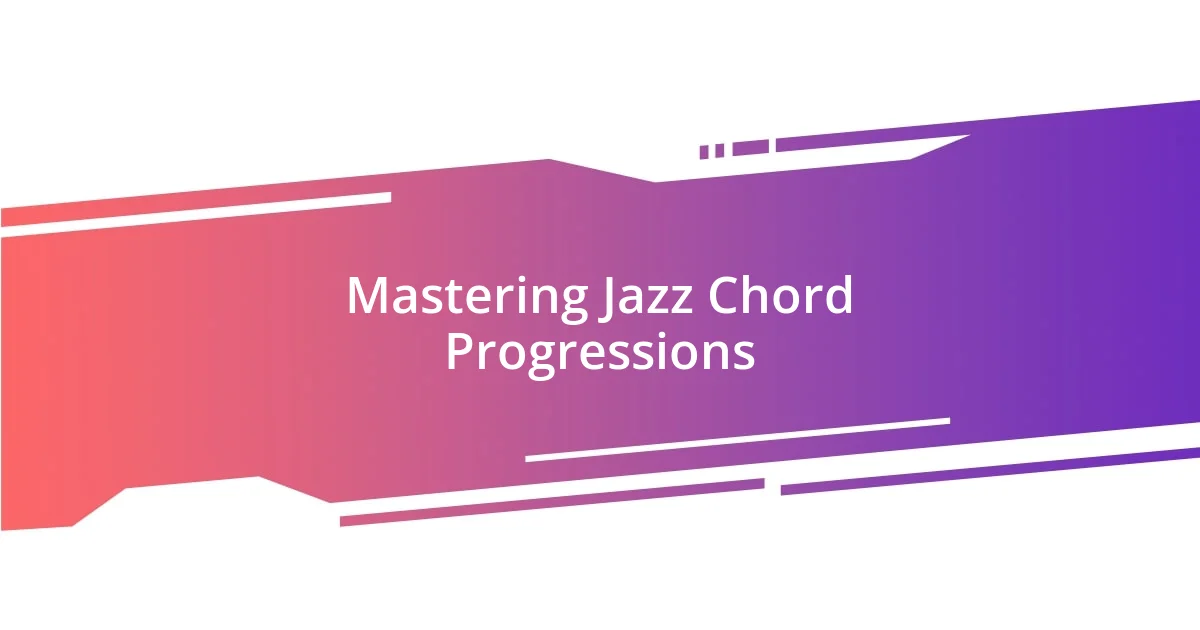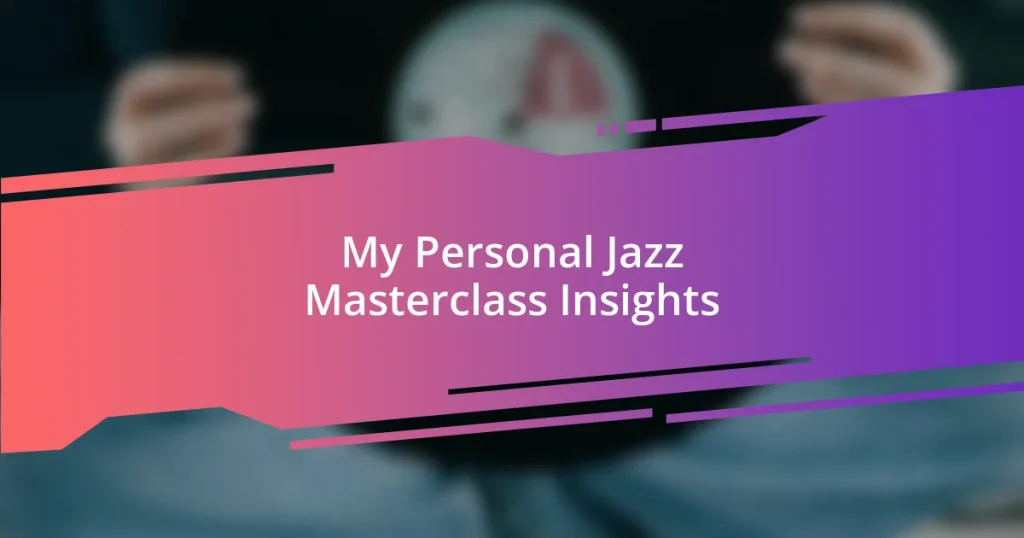Key takeaways:
- Improvisation is central to jazz; it involves developing a unique voice by engaging with the music and listening to influences.
- Mastering jazz chord progressions, such as ii-V-I and blues progressions, allows for creating tension and resolution, enhancing emotional expression through music.
- Practicing jazz standards promotes personal expression and understanding of musical structures, encouraging reinterpretation and creativity within established forms.

Understanding Jazz Fundamentals
When I first dove into jazz, I remember feeling a mix of excitement and confusion. The fundamental elements—like swing, syncopation, and improvisation—seemed so alien yet fascinating. Have you ever felt that thrill when the rhythm just takes over? It’s the heartbeat of jazz, and understanding it can transform your playing.
Improvisation is at the core of jazz, and for many, it’s like jumping into a deep pool without knowing how to swim. I recall the first time I improvised on stage; my heart raced, but the freedom felt exhilarating. It’s essential to remember that every solo is a conversation—your voice must have something to say. How do you develop your unique sound? Start by listening closely to the greats; they’ve left breadcrumbs on the journey to mastery.
Another fundamental is the use of harmony and chord progressions. Early on, I struggled with the complexity of jazz chords, often feeling overwhelmed. But I found that breaking them down into smaller parts made them manageable. Have you ever dissected a favorite song to understand the chords? This practice not only builds your confidence but also deepens your connection to the music.

Exploring Jazz Improvisation Techniques
Jazz improvisation techniques offer endless avenues for expression and creativity. One of my favorite approaches involves playing around with motifs—short musical phrases that serve as a starting point. I remember a jam session where I developed a simple motif, then watched in disbelief as it morphed into a conversation with the other musicians. Embracing this technique not only fosters spontaneity but also creates an organic dialogue with your fellow players.
Here are some effective jazz improvisation techniques to consider:
- Motif Development: Start with a memorable phrase and evolve it throughout your solo.
- Call and Response: Mimic the conversation aspect of jazz by alternating between playing and listening.
- Triadic Arpeggios: Use arpeggios to outline chord changes, giving your lines more cohesion.
- Color Tones: Incorporate non-chord tones to add depth and richness to your phrases.
- Rhythmic Variation: Change up your rhythmic feel to maintain interest and push the boundaries of your solos.
Exploring these techniques helped me break out of my comfort zone, revealing newfound confidence in my improvisational voice. It’s like learning a new language; initially daunting, but exhilarating as you begin to express yourself with fluidity and emotion.

Mastering Jazz Chord Progressions
Mastering jazz chord progressions is akin to understanding the DNA of the music. I vividly remember my first time playing through the iconic ii-V-I progression; it felt like unlocking a secret passage in a familiar song. The beauty of these chords lies in their ability to create tension and resolution that keeps listeners on the edge of their seats. Have you ever felt that rush when the music flows seamlessly? That’s the power of mastering chord progressions—drawing your audience in deeper with every phrase.
The complexity of jazz chords can initially be intimidating. However, through consistent practice, I discovered that understanding their structure made them less daunting. For instance, learning to incorporate diminished chords into progressions helped me add surprising twists to my playing. Have you explored this? Once I started to think of chord progressions as a storytelling tool, the fear started to dissipate, and the music began to speak through me.
I find that each chord progression brings a unique flavor to the music. Whether you’re using a simple major scale or venturing into more complex substitutions, your choices paint a picture. I once experimented with a standard blues progression but added chromatic chords, which transformed the entire feel of the piece. This realization sparked a creative fire in me. It’s all about trial and error; the more you explore, the richer your musical palette becomes.
| Chord Progression Type | Characteristics |
|---|---|
| ii-V-I | Sets up a smooth transition to tonic; creates tension and resolution. |
| Blues Progression | Follows a predictable pattern; great for improvisation and expression. |
| Circle of Fifths | Establishes a dynamic flow; encourages movement through various keys. |

Developing Your Unique Jazz Style
Developing your unique jazz style requires a blend of personal expression and technical skill. I remember the first time I decided to fully embrace my quirks in my playing—my teacher noted that my fingerings were all over the place, but my sound had an authenticity that was magnetic. It hit me then: what I perceived as flaws were actually my stamp of individuality. Have you ever felt that moment when you realize your uniqueness is your strength?
As you explore various influences and techniques, it’s crucial to sift through them and find what truly resonates with you. I recall picking up on elements from different genres—like the improvisational freedom of jazz combined with the storytelling of blues. In one instance, I blended a jazz standard with a soulful R&B groove; it felt like an exhilarating ride where every note echoed my essence. This encouraged me to push boundaries and create a sound that felt unmistakably “me.”
Listening to different artists is invaluable, but don’t just mimic their style—let their influence simmer and inspire your unique take. I still remember the thrill of transcribing a Charlie Parker solo, only to find that I gravitated toward adding my nuances and rhythms. It’s all part of the journey of self-discovery as a musician. How are you embracing your style? The beauty of jazz lies in its ability to evolve, reflecting your experiences and emotions, making every performance a personal narrative.

Analyzing Famous Jazz Performances
Analyzing famous jazz performances opens a treasure trove of insights that can transform our understanding of the genre. I often find myself captivated by the sheer creativity displayed in iconic solos, like John Coltrane’s “Giant Steps.” The way he navigates through complex chord changes feels like watching a master chess player in action. Have you ever noticed the brilliant interplay between tension and release in those moments? It’s a reminder that jazz isn’t just about playing notes; it’s about telling a story.
One performance that still resonates with me is Miles Davis’s “So What.” The minimalist approach he took, with its haunting melody and subtle complexities, exemplifies how less can truly be more in jazz. His call-and-response interactions with the band evoke a certain dialogue that pulls you in. I remember the first time I listened deeply, captivated by how every musician contributed their voice while maintaining that enchanting, collective atmosphere. It makes you wonder: how can such simplicity create such profound impact?
In studying performances, I often reflect on the emotional range displayed by artists during live shows. For instance, when I watched a recording of Ella Fitzgerald’s improvisational skills, I was struck by her ability to convey joy and sorrow in the same breath. It made me realize that capturing emotional authenticity is vital to my own playing. Have you found a performance that hit you right in the feels? The ability to express vulnerability through music is something I strive for—it’s the core of what makes jazz resonate with so many.

Practicing with Jazz Standards
Practicing with jazz standards is like having a conversation with the past while shaping your present sound. I vividly recall my first attempt at “Autumn Leaves”; the melody felt familiar yet foreign. It was like trying to wear someone else’s shoes—awkward at first, but exhilarating once I found my footing. Have you ever experienced that mix of excitement and challenge when tackling a classic tune?
A significant part of practicing standards is digging into the harmonic structure. I often spend hours exploring the chord changes, trying to understand the journey they take me on. When I first grasped the concept of ii-V-I progressions, it was like uncovering a secret pathway in a labyrinth. By connecting those dots, I found that I could play freely, improvising my own lines within the framework. It’s fascinating how jazz standards serve not only as benchmarks but as launching pads for personal expression. How does delving into these structures enhance your understanding of the music?
Engaging with jazz standards also opens up a world of stylistic interpretation. I remember a session where I decided to swing “Blue Bossa,” adding my flair with different rhythmic accents. This small change transformed the piece into something fresh while still honoring its roots. It made me realize that practicing these standards isn’t just about replication; it’s about interpretation and finding your voice within established forms. Have you tried putting your spin on a classic? It’s moments like these that reaffirm my love for jazz, making it a canvas where I can freely paint my musical story.

Applying Insights to Personal Growth
There’s something incredibly rewarding in applying insights from jazz into personal growth. I recall a time when I was preparing for a performance, feeling the familiar anxiety bubble up. It dawned on me then—jazz’s essence lies in embracing imperfection. Instead of fixating on the fear of mistakes, I focused on the spontaneity of each note. This shift helped me transform that anxiety into a sense of liberation. Have you ever let go of fear and played with pure joy?
Channeling the improvisational spirit of jazz has taught me the importance of flexibility. Like when I’m in a jam session, I’ve learned to adapt to the unexpected—a sudden tempo change or an unanticipated solo from a fellow musician can completely alter the flow of the piece. This adaptability has bled into my daily life, helping me navigate challenges with a more fluid mindset. How has your experience shaped your response to the unexpected? I find that life’s surprises often lead to growth moments, just like an unexpected twist in a jazz piece.
Moreover, the collaborative nature of jazz reminds me that personal growth isn’t a solo endeavor. I vividly remember a workshop where we created a piece collectively, with each musician adding their unique touch. It felt powerful to merge our ideas, reminding me that growth is richer when shared with others. Just like in jazz, where every voice contributes to a vibrant tapestry of sound, I believe our interactions and collaborations fuel our personal journeys. How could inviting others into your growth process enhance your experience?















